Angling Season 150th Anniversary
- 20/11/2024
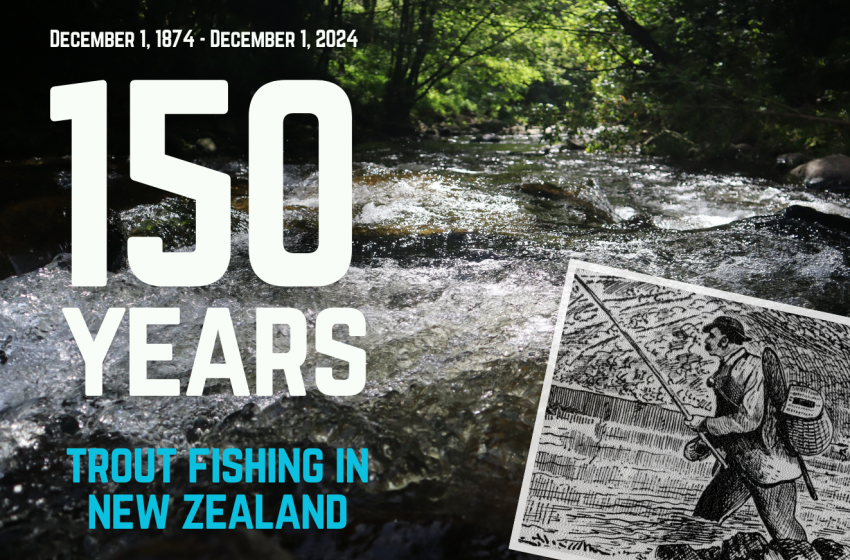
150 years of trout fishing in New Zealand
New Zealand is marking a remarkable milestone in angling history: the 150th anniversary of the nation’s first licensed freshwater sports fishing season.
On December 1, 1874, the Otago Acclimatisation Society — the forerunner to Otago Fish & Game Council — launched the historic three-month trout fishing season, laying the foundations for a longstanding Kiwi tradition of freshwater angling.
This anniversary marks the beginning of a treasured national pastime that has become a cornerstone of New Zealand’s outdoor culture, bringing together generations of anglers to enjoy the country’s rivers, lakes, and streams.
(Artwork extract from the New Zealand Graphic and Ladies Journal, 1890. Auckland Libraries Heritage)
Watched by an interested crowd, Otago Acclimatisation Society rangers Messrs Black and Beck net spawning trout in the Leith during an exercise to strip ova for use at the hatchery. Otago Witness, July 14, 1909.
A historic beginning
The story of trout fishing in New Zealand began in the late 19th century, as acclimatisation societies worked to introduce fish and game species in the colony.
By 1868 and 1869, imported trout ova had been successfully incubated at Ōpoho Stream in Dunedin.
These were released into nearby waters ‒ the Water of Leith, Shag River, Silver Stream, Waitati River, Kakanui River, Waikouaiti River, Island Stream, and “Fulton’s Creek”, in West Taieri, thought to be now part of the Contour Channel.
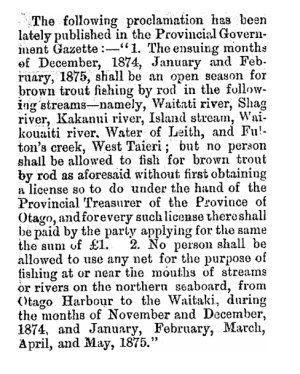
Acclimatisation report in Otago Daily Times, 25 November 1874, Page 2.
First angling season
In late 1874, after years of planning, the Otago Acclimatisation Society determined that trout numbers were sufficient to allow limited fishing in the streams where they had been first released. The society proposed a three-month season, covering December, January, and February, and the Provincial Government gazetted the waterways for angling. Licences were introduced for the first time, costing one pound, equivalent to approximately $160 today.
The inaugural legal trout fishing season in New Zealand officially began on December 1, 1874. It was a moment of great anticipation, as anglers prepared to test their skills in local waters.
Alexandra Campbell Begg, a 19th Century identity in Dunedin and founding member of the Otago Acclimatisation Society, had the distinction of catching the first legal trout in the Water of Leith on December 1, 1874. Credit: Begg family descendants/Otago Daily Times
Opening day: a historic catch
On the opening day, Alexander Campbell Begg made history by catching the first legal trout under licence in the Water of Leith. In a single afternoon, he caught 20 trout weighing a combined 13 pounds (nearly 6 kilograms), all using fly-fishing techniques.
The Otago Witness noted that “good baskets” of trout were taken, with some fish weighing over three pounds.
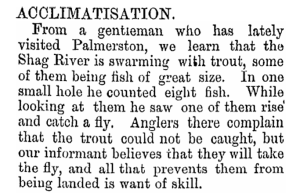
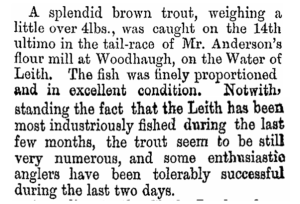 Otago Witness, March 13, 1875
Otago Witness, March 13, 1875
Reports from the inaugural season highlighted the enthusiasm of anglers and the quality of the fishing. Fishing activity centred around on the Water of Leith and the Shag River. Anglers were eager to experiment with different flies and techniques, and debates quickly emerged about methods and anglers’ skills.

An illustration from The New Zealand Graphic and Ladies Journal, 20 December 1890. Fishermen fishing in the Water of Leith, Dunedin. The stream is so narrow, fishermen on opposite banks have got their lines tangled together. Credit: Auckland Libraries Heritage Collections NZG-18901220-0006-01
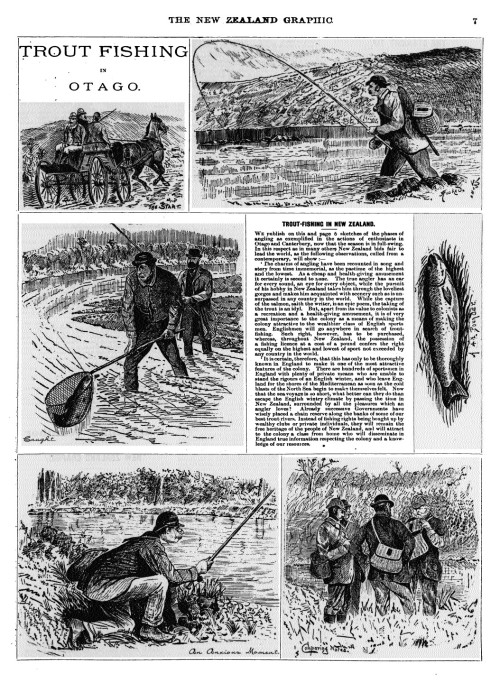 A montage of illustrations of trout fishing in Otago in The New Zealand Graphic and Ladies Journal, 20 December 1890, page 7. Credit: Auckland Libraries Heritage Collections NZG-18901220-0007-01
A montage of illustrations of trout fishing in Otago in The New Zealand Graphic and Ladies Journal, 20 December 1890, page 7. Credit: Auckland Libraries Heritage Collections NZG-18901220-0007-01
A national pastime takes shape
The success of the first season set the stage for trout fishing to become a popular national pastime. Over the next 150 years, the sport grew in popularity, with more than 130,000 anglers now heading to New Zealand’s freshwater fishing spots annually.
While rods, reels, and other equipment have evolved dramatically since the 19th century, the essence of the sport remains the same: the pursuit of a wild and elusive fish with a fly, lure or bait. For many, trout fishing is more than a sport—it’s a way to connect with nature, unwind, share memorable experiences with friends and family, and bring home food for the table.
Descendants of Alexander Campbell Begg (front from left) Amanda Mulligan, Lal Mulligan and James Barclay with a Hardy split-cane fly rod of Mr Begg’s which they donated to Toitū Otago Settlers Museum. Photo: Otago Daily Times
The evolution of angling
In the early days of trout fishing in New Zealand, anglers relied on split-cane rods, silk lines, and handmade flies. These rods, often crafted from bamboo and joined with brass ferrules, were long and sturdy, designed for large rivers and heavy fish.
Fly reels were typically made of brass or ebonite and featured simple click-and-pawl mechanisms. Flies, imported from Britain or tied locally, used natural materials like feathers and fur. Anglers experimented with patterns to match the local insect life, adapting their patterns to New Zealand’s unique conditions.
Today, advancements in materials and technology have transformed fishing equipment. Lightweight carbon fibre rods, precision-engineered reels, and synthetic lines offer greater accuracy and durability. Modern anglers also benefit from innovations like soft plastics, braided lines, and advanced lures, which make the sport more accessible and versatile than ever before.

An Otago trout fishing licence for the 1878-79 season cost one pound, equivalent to about $160 in today’s currency.
A heritage of fisheries management and conservation
From its earliest days, trout fishing in New Zealand has been closely linked with fisheries management and protecting habitat.
This tradition continues today through the work of Fish & Game councils across the country. Anglers’ licence fees fund vital projects, including habitat restoration, water quality monitoring, water conservation orders, and access improvements. By participating in the licensing system, anglers play a direct role in protecting New Zealand’s freshwater resources for future generations.
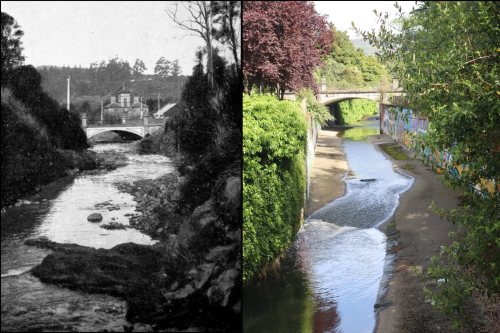
The Water of Leith downstream of the George Street bridge in 1913 (left) in comparison with the channelised concrete riverbed in 2024. Credits: Otago Witness collection; Otago Fish & Game.
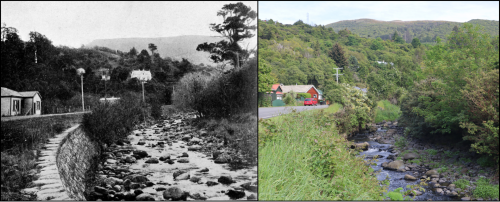
The Water of Leith in Glenleith in 1914 (left) in comparison with 2024. Credits: Otago Witness collection; Otago Fish & Game
The Water of Leith: A river transformed
The Water of Leith, where the first legal trout was caught, has undergone significant changes over the past 150 years. Once a pristine stream flowing through Dunedin, the Leith has been heavily modified by urbanisation, agriculture, and flood protection measures. Today, much of its lower reaches are channelised with concrete banks and weirs, designed to manage stormwater and prevent flooding.
University of Otago PHD student Ryan Easton (left) operates an electrofisher as Olivier Raven and Sophie Whittall collect fish for monitoring in the Water of Leith in Dunedin in 2023. Photo: Bruce Quirey, Otago Fish & Game
Despite these challenges, the Leith remains an important habitat for brown trout. Scientific monitoring, conducted by the University of Otago in collaboration with Otago Fish & Game, has revealed valuable insights into the river’s ecology. Researchers have identified critical spawning areas and studied the impacts of flood events and migration barriers on fish populations.
Legal fishing in the Leith is now restricted to the section downstream of its confluence with Lindsay Creek near the Dunedin Botanic Garden. The river does not offer the same quality angling as in the past but continues to attract anglers. The fishery is carefully managed to ensure sustainability.
In spite of the unpromising weather this morning, this angler was trying his luck (and his skill) in the Water of Leith. Credit: The Evening Star, 2 October 1948
Reflecting on 150 years
The 150th anniversary of trout fishing in New Zealand offers an opportunity to reflect on the sport’s enduring appeal and positive contributions. Recreational angling is woven into the fabric of New Zealand’s outdoor heritage. Trout are a part of our ecosystem, recognised as a valued introduced species.
Looking back on the past 150 years, we are proud of the unbroken history of fisheries management and the benefits that has brought to the environment and economy.

A good catch from the Water of Leith. Fishing in the Leith canal, adjacent to Messrs Gregg and Co.'s factory, on Monday night, Mr H. O. Marsh landed a particularly fine specimen of a sea-run trout. The fish weighed 12½lb and was 33 inches long and seven inches in depth. Mr Marsh used the Golden Devon minnow as a lure, and it took him a good half-hour to secure the fish. He fished from 5 o'clock to 7 o'clock, and during that period he caught five fish of a total weight of 35lb. Credit: Otago Daily Times, 28 April 1937
Looking ahead
As New Zealand marks 150 years of trout fishing, the focus remains on the future. Fish & Game councils are committed to working alongside mana whenua, local communities, and government agencies to protect and enhance freshwater habitats.
These efforts ensure that trout fishing will continue to be a source of enjoyment, inspiration, and connection for generations to come.
Whether you’re an experienced angler or a newcomer to the sport, the 150th anniversary is a chance to celebrate this heritage. Cast a line, explore a nearby river, or simply take a moment to appreciate the enduring legacy of trout fishing in New Zealand.
The upper Leith in 1912. Credit: Otago Witness collection
References:
- Otago Witness
- Otago Daily Times
- “Dart Athwart the Mountain Torrents: The Introduction of Brown Trout to New Zealand”, PHD thesis, 2017, Jack Kós
- “Gamekeepers for the nation”, 1994, R.M. McDowall
- Otago Acclimatisation Society reports